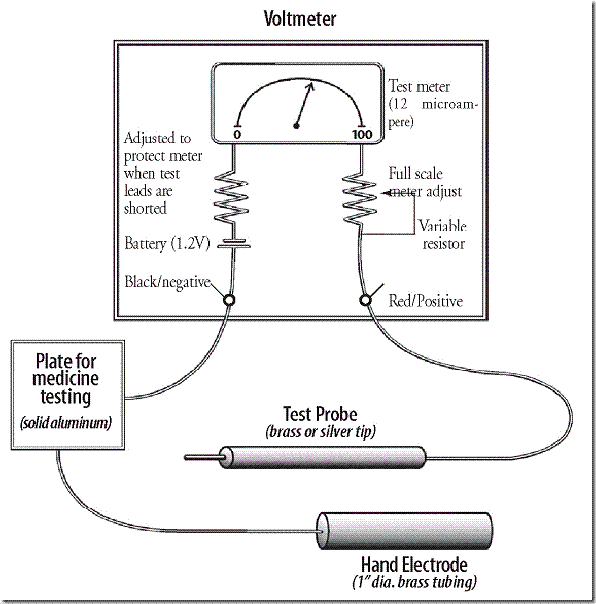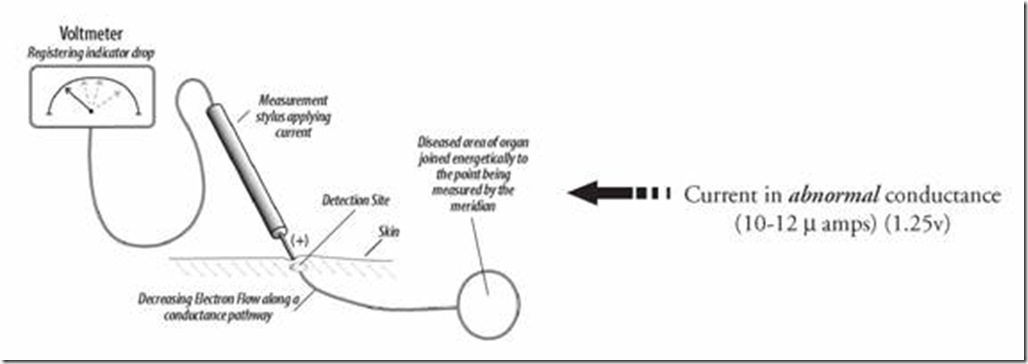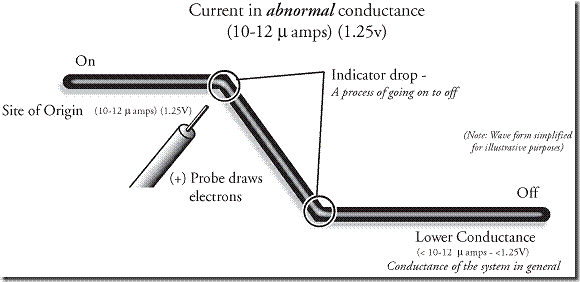Acupuncture evolved from ancient Chinese observations of a correspondence between energy in meridians and the condition of organs and systems in the human body. The science of acupuncture views meridian dysfunction as an indicator of organ or system dysfunction. Acupuncturists observed that stimulation of points along the meridian was selective for correcting this dysfunction.
Ellis, Andrew, Wiseman, Nigel & Boss, Ken, Fundamentals of Chinese Acupuncture, Revised Edition (Brookline: Paradigm Publications 1991)
Robert Becker demonstrated that certain areas of the skin have a conductive response better than others. These areas of enhanced conductance lie in locations overlying the meridians. Becker, Robert O. & Selden, Gary, The Body Electric (New York: William Morrow 1985)
Becker, Robert O., Cross Currents (Los Angeles: Jeremy P. Tarcher 1990
Rheinhold Voll et al were able to demonstrate a response in the organ and system sites when they stimulated the corresponding skin points with a small electrical current. Their method was o place the subject in an open circuit with the subject holding the ground wire of the circuit. top
A painless voltage from a DC battery was introduced into the series circuit. The circuit was closed when the positive probe was touched to the skin surface. One of two outcomes could be observed. 1) The resistance of the skin would not change over the span that the probe was applied, and 2) The resistance would decrease over the span of time the probe is applied. The first condition was defined as an ‘indicator balance’. The latter condition was defined as an ‘indicator drop’. Using the Chinese acupuncture paradigm, the indicator status of the ‘balance’ or ‘drop’ was representative of changes occurring at sites correlating to the acupuncture point.
This paradigm held that electromagnetic indicator balance was representative of normality at that acupuncture point; whereas an indicator drop was representative of an abnormality.
Voll, et al also observed that indicator drops could be “balanced” by introducing certain substances into the circuitry. These observations, made initially by serendipity, developed into a robust system of site detection and voltage balancing. When first discovered, substances were simply held in proximity to the subject. Subsequently substances have been placed in proximity to an aluminum test plate that was part of the series loop of the detection device.
More recently information from a large variety substance has been digitized by analog to digital conversion and stored in a computer as a binary code. Most computers store around 4000 to 5000 signals. They can be placed in the series loop manually or blindly when selecting for signal balance. Coded signals include chemicals, pharmaceuticals, herbals, homeopathic remedies, sarcodes (organs), biologicals, metals, toxins, nutrients, and metabolic substances. A listing of these computer codes will be the subject of future web logs.
Detection of internal events by electrical changes in the skin is commonplace in medicine today. Electrocardiograms and electroencephalograms are two technologies that reflect voltage changes in the skin as a result of changes in voltage in the heart and brain respectively. Oximeters, pulse-rate meters, and digitized blood pressure are some of the other devices that are used extensively for rapid and continuous patient monitoring.
This web log is my attempt to address some of the problems of technique and language in electrodermal detection so as to make this technology understandable. Future discussions will focus on clinical conditions that can be addressed by most of you who are interested in this exciting new way of looking at medical problems.
The detection system consists of:
A closed loop circuit in series with:
A biological subject
A computer
A software program with digitized codes
An electronic device with: an analog to digital and a digital to analog integrated circuit A DC battery.
The system is connected in series with a test subject holding a negatively charged brass hand piece and an operator holding a positively charged probe. During the time operator touches the skin of the test subject with the probe an electromagnetic current is conducted through the system at 1.25v, 10-12 μ amps. The subject resists at 95 kilo ohms. One of two things happens to the voltmeter dial during this time of application: either the dial remains steady ‘Balanced’, or it drops ‘Indicator drop’. If the dial remains steady it implies that there is electromagnetic conductance through the system. It is “on”. If the dial drops, it implies that there is a decrease of conductance through the system. It is “off”. The application of a current generated in the device causes the biological host to respond. It is a bio-feed back reaction to an electric stimulus. The “indicator drop” is therefore a phase going from conductance to non-conductance. It is the phase of going from “on” to “off”. Since “on” is good and “off” is bad, an attempt is made to turn the system “on”, that is restore full conductance.
Restoring conductance is done by doing two things:
1) Select a code producing a balance by sorting through the software encoded signals in the computer.
2) Place a substance directly on a test plate that is in the series circuit if a computer is not used
An analog to digital integrated circuit converts the amplitude of the analog wave in the subject’s electromagnetic pathway to a square wave that is encoded in the computer software. The algorithm of this integrated circuit converts the amplitude of an analog wave to an equivalent width square wave.
During the detection process the stored digital codes, as part of the series circuit, pass through another integrated circuit, one that converts a digital to analog wave identical to the subject’s analog wave. It is this reconstructed wave that interacts with the subject’s analog wave that is conducting information from a site within the body to the skin surface.
Galvanic skin resistance is measured at the probe site on the skin surface. By Ohm’s Law, Resistance =1/Conductance, so in effect when we measure skin resistance we also measure conductance. The conductance pathway from a specific site within the body is determined by the site where the probe is placed.
Codes in the software are a sting of ‘1’s and ‘0’s (Reminds me of ancient Latin scripts without punctuation) but fortunately the computer programmers have been able to isolate the encrypted codes and have made provision for assigning the encryptions with a ‘plain language’ name so that we can identify them. The encryption and the plain language name can be catalogued for later use.
The name “Electroacupuncture” is somewhat misleading. Electrodermal detection is not invasive, skin is not being punctured and a current of injury is not being produced. Acupuncture is a therapeutic method, whereas, electrodermal detection is simply that – a detection method. It utilizes an information gathering device that measures skin resistance for detecting frequencies that originate in the body and are expressed or detected on the skin. These detection sites are aligned in linear arrays that generally correspond to the acupuncture meridia.
In acupuncture theory, energy flows through the meridia, but this theory has yet to be firmly established. One can see from the Atlas of Detection Sites a clear linear distribution of sites. These sites are discrete. Each detection site on the skin represents a discrete site of origin for a signal within the body. There are similarities and differences of the detection sites. Part of the signal causes it to resonate along the detection array on the skin surface but part of the signal causes it to be discrete enough to be detectable only at certain sites along the array
In an effort to make frequency detection more clinically relevant, I have developed a manual listing the currently known detection sites according to organs and systems and have indexed them so that they can be located on a page in the Atlas of Detection Sites. The atlas graphically illustrates the detection sites according to their location on the body. Since there is an overlap between acupuncture points and electrodermal detection sites, some still use the older acupuncture point terminology. I refer to ‘acupuncture points’ as ‘detection sites’ and ‘acupuncture meridians’ as ‘detection arrays’.
I made a manual of electrodermal profiles for clinical conditions. This is my attempt to fit electrodermal detection into a scheme that may be used for medical care management as a complementary tool or as a ‘stand alone methodology’. There are patterns of electromagnetic signals associated with clinical diagnoses. These patterns are very complex and change over time. In this series, I hope to demonstrate that modification of electromagnetic signals parallels clinical improvement. It is not hard to do.
References:
Becker, Robert O. & Selden, Gary, The Body Electric (New York: William Morrow 1985)
Becker, Robert O., Cross Currents (Los Angeles: Jeremy P. Tarcher 1990)
Tsuei, Julia, Lam, Fred M. K. & Chou, Pesus Clinical Application of the EDST (IEEE Engineering in Medicine and Biology Magazine pp 67-75, Volume 15, Number 3 1996)
Tsuei, Julia, Science of Acupuncture-Theory and Practice (IEEE Engineering in Medicine and Biology Magazine pp 52-57, Volume 15, Number 3 1996)
Yeargers, Edward K. Basic Physics for Biology (Boca Raton: CRC Press 1992)
Werner, Fritz, Electro-acupuncture Primer (Uelzen: Medizinisch Litarische Verlagsgesellschaft mbH 1979)
Wolfgang, Larry D., Understanding Basic Electronics (USA: The American Radio Relay League 1992)
Bechtloff, Friedrich, Electroakupunctur nach Voll: EAV; eine Darstellung in Bereichen (Uelzen: Medizinisch Literarische Verlagsgesellshaft 1991)
Brügemann, Hans, Bioresonance and Multiresonance Therapy (Brussels: Haug 1993)
Carpenter, David O. & Ayrapetyan, Sinerik, Biological Effects of Electric and Magnetic Fields, Volume 1 & 2(San Diego: Academic Press 1994)
Chen, Kuo-Gen, Electrical Properties of Meridians (IEEE Engineering in Medicine and Biology Magazine pp 58-63, Volume 15, Number 3 1996)
Chu-Andrews, Jennifer, & Johnson, Robert J., Electrodiagnosis: An Anatomical and Clinical Approach (Philadelphia: J.B. Lippincott 1986)
Dempster, John, Computer Analysis of Electrophysiological Signals (London: Academic Press1993
Ellis, Andrew, Wiseman, Nigel & Boss, Ken, Fundamentals of Chinese Acupuncture, Revised Edition (Brookline: Paradigm Publications 1991)
Gerber, Richard, Vibrational Medicine (Santa Fe: Bear & Company 1988)
Hecker,Hans-Ulrich, Steveling, Angelica, Peuker, Elmar, Kastner Jörg & Liebchen, Kay, Color Atlas of Acupuncture (Stuttgart: Thieme 1999)
Kenyon, Julian N., Modern Techniques of Acupuncture Volume I-III (Willingborough, Northamptonshire England: Thorsons Publishing Group 1985)
Leber, Douglas C. Acupro II System™, Computronix Corporation, 1991
Petzold, Charles, Code (Redmond: Microsoft Press 1999
Pohlmann, Ken C., Principles of Digital Audio, 3rd Edition (McGraw-Hill 1995)
Popp. Fritz-Albert, Warnke, Ulrich, König, Herbert L.& Peschka, Walter, Electromagnetic Bio-Information 2nd Edition (München-Wien-Baltimore: Urban and Schwartzenberg 1989)
Richer, Paul, Anatomie Artistique, Paris, 1889. Translated and edited by Hale, Robert B., Artistic Anatomy (New York: Watson-Guptill Publications 1971)
Serway, Raymond A.,and Faughn, Jerry S., College Physics Vol 1& 2, 5th Edition (Fort Worth: Saunders College
Publishing 1999)
Wolfgang, Larry D., Understanding Basic Electronics (USA: The American Radio Relay League 1992)
Vincent J. Speckhart M.D.
.



